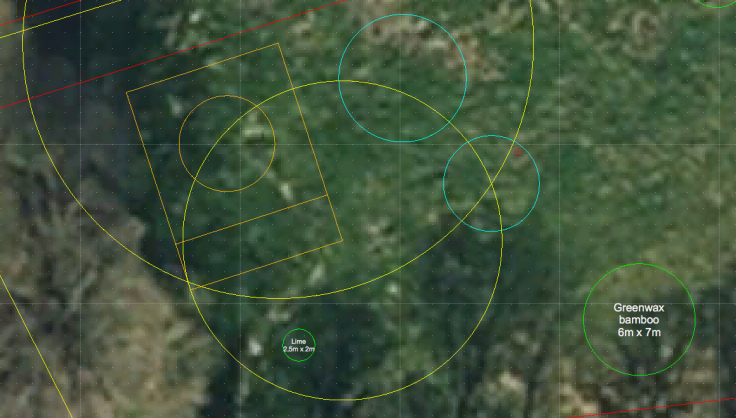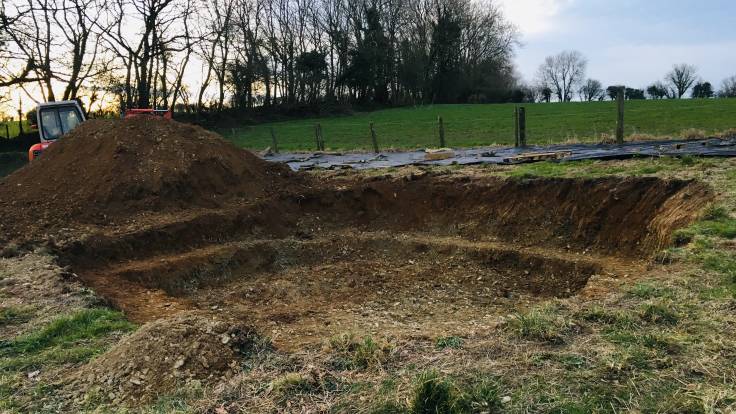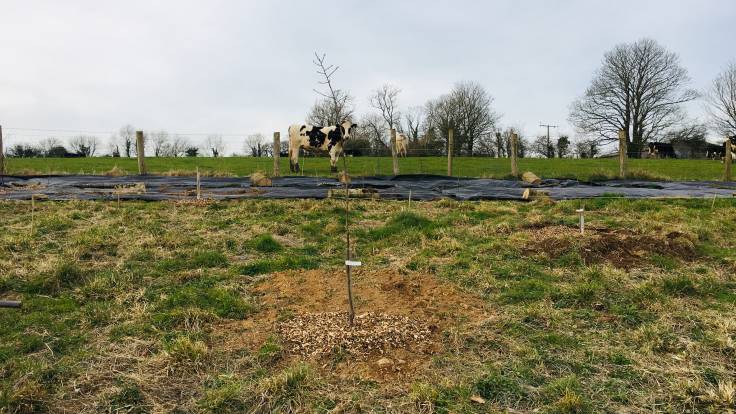
Big sky over the Ornamental Forest Garden
The first stage of the Ornamental Forest Garden is complete and there are large gaps about the place. This is fine, for now.
We’ve planted the canopy layer in the Ornamental Forest Garden, a new, greenfield, 1 acre site. Up to a couple of weeks ago, I was measuring and planning, using a tape measure, CAD software, bits of bamboo and lots of string.

Using circle radius on the CAD plan to work out positions
Then, the digger arrived, to dig the wildlife pond and level an area for the forest garden workshop tent. It was a lot of work, 3 days digging, and great to see the hard landscaping shape the garden. But it did mean I had to finally plant the canopy layer trees.

The new pond in the new Ornamental Forest Garden
I had ordered quite a few trees and shrubs from Agroforestry Research Trust and they’d been heeled-in to a raised bed for a couple of months. The warm weather in February made me nervous, leaving it any longer would increase the likelihood of needing to keep the trees well watered throughout the summer. The full list of trees is here:
- Cornelian Cherry (Cornus mas) Gourmet
- Haw Crataegus arnoldiana
- Bladdernut (Staphylea pinnata)
- Chestnut (Castanea) Marigoule seedling
- Hazelnut (Corylus avellana) Corabel, Webbs prize Cob
- Elaeagnus umbellata Big Red
- Highbush Cranberry (Viburnum trilobum) Phillips, Wentworth
- Phyllostachys viridi-glaucescens
- Yushania anceps Pitt White
Plus I moved the Mulberry and Cornus kousa ‘Chinensis’ from the other forest garden, to a more sheltered position. Together with a couple of plum Excalibur and apples grafted (Ashmead’s Kernel and Poppit Bubblegum) by own fair hand, that’s enough canopy layer to be getting on with.
In terms of ornamentality, the Cornelian Cherry currently has beautiful witchhazel-like yellow blossom, the Hawthorn will have a glorious spring display and the Highbush Cranberry have beautiful open flowers in spring and glorious autumn red berries.

Plum Excalibur in the foreground, with young Italian Alder whip to the left, and Hazel 'Webbs Prize Cob' to the right
What I did notice was quite a lot of space. There’s only a couple of shrubs in the list, the smallest probably being the Highbush Cranberry. That’s fine, these things will grow, and with the windbreaks pretty much planted for this year, my work is for the most part done.
When the tent gets put up and we start to use the space for tours and workshops, then we’ll get a better idea of how to design the other areas. From the big things (tent, pond, trees) down to the detail, in easy stages. There will be a wildflower section, perennial vegetables near the tent, probably more windbreaks and nurse trees. But all in good time. Leave some space now for things to grow.